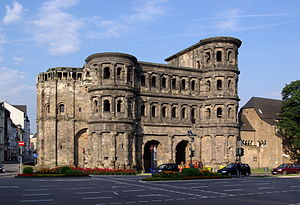Porta Nigra
| Porta Nigra | |
|---|---|

The Porta Nigra viewed from the north.
|
|
| General information | |
| Type | City gate |
| Architectural style | Roman |
| Location | Trier, Germany |
| Coordinates | 49°45′35″N 6°38′38″E / 49.75972°N 6.64389°ECoordinates: 49°45′35″N 6°38′38″E / 49.75972°N 6.64389°E |
| Construction started | 186 AD |
| Completed | 200 AD |
| Official name | Roman Monuments, Cathedral of St. Peter and Church of Our Lady in Trier |
| Type | Cultural |
| Criteria | i, iii, iv, vi |
| Designated | 1986 (10th session) |
| Reference no. | 367 |
| Region | Europe and North America |
The Porta Nigra (Latin for black gate) is a large Roman city gate in Trier, Germany. It is today the largest Roman city gate north of the Alps. It is designated as part of the Roman Monuments, Cathedral of St. Peter and Church of Our Lady in Trier UNESCO World Heritage Site.
The name Porta Nigra originated in the Middle Ages due to the darkened colour of its stone; the original Roman name has not been preserved. Locals commonly refer to the Porta Nigra simply as Porta.
The Porta Nigra was built in grey sandstone between 186 and 200 AD. The original gate consisted of two four-storied towers, projecting as near semicircles on the outer side. A narrow courtyard separated the two gate openings on either side. For unknown reasons, however, the construction of the gate remained unfinished. For example, the stones at the northern (outer) side of the gate were never abraded, and the protruding stones would have made it impossible to install movable gates. Nonetheless, the gate was used for several centuries until the end of the Roman era in Trier. It serves as an entrance to town.
In Roman times, the Porta Nigra was part of a system of four city gates, one of which stood at each side of the roughly rectangular Roman city. The Porta Nigra guarded the northern entry to the Roman city, while the Porta Alba (White Gate) was built in the east, the Porta Media (Middle Gate) in the south, and the Porta Inclyta (Famous Gate) in the west, next to the Roman bridge across the Moselle. The gates stood at the ends of the two main streets of the Roman Trier, one of which led north-south and the other east-west. Of these gates, only the Porta Nigra still exists today.
In the early Middle Ages the Roman city gates were no longer used for their original function and their stones were taken and reused for other buildings. Also iron and lead braces were broken out of the walls of the Porta Nigra for reuse. Traces of this destruction are still clearly visible on the north side of the gate.
...
Wikipedia
